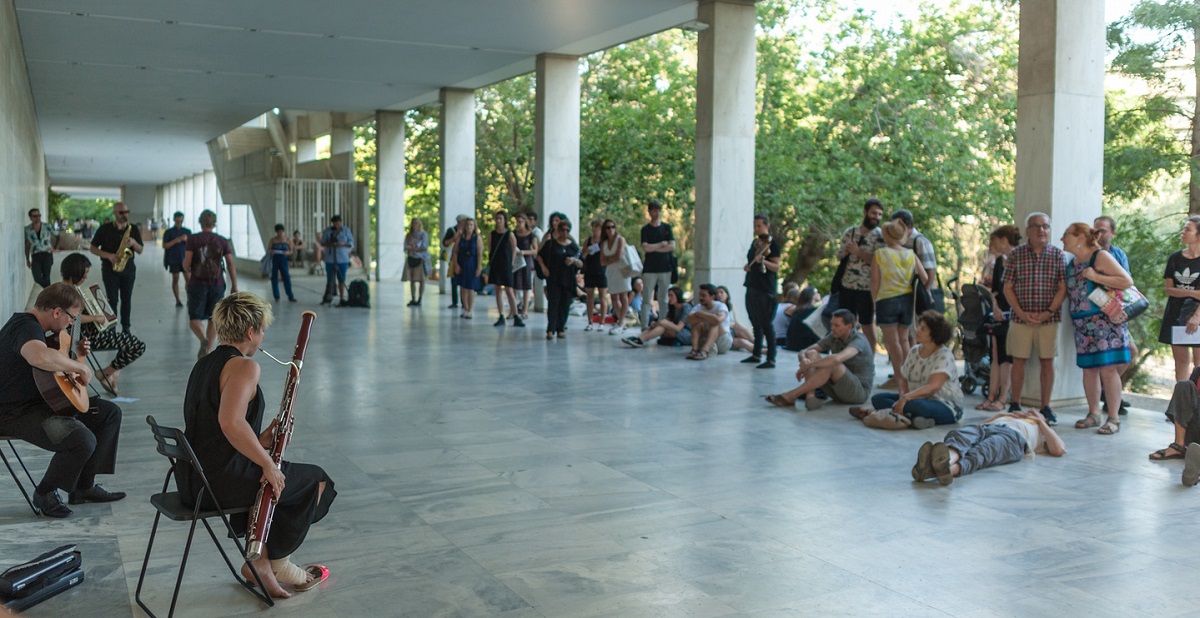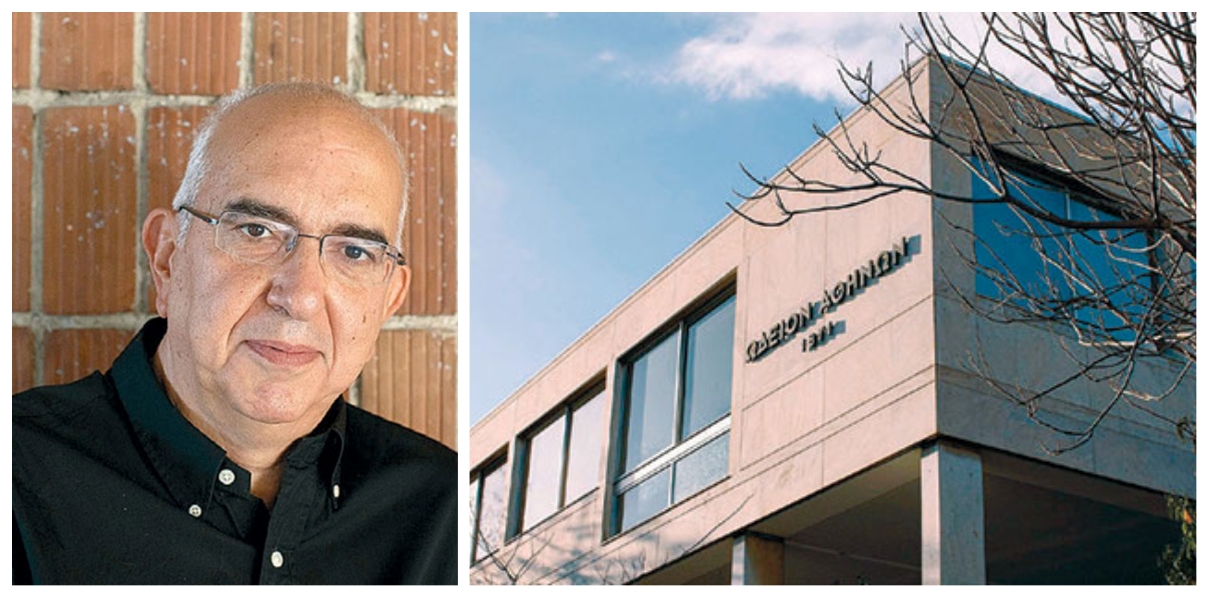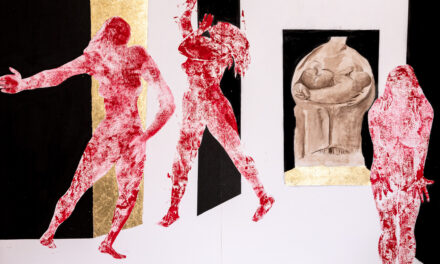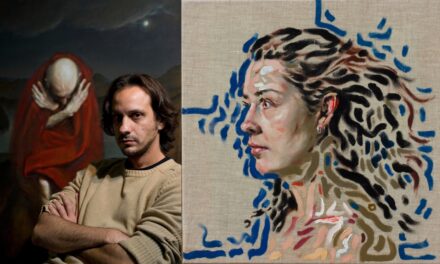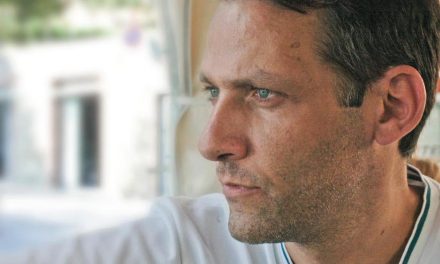Nikos Tsouchlos is Associate Professor at the Department of Music Studies of the Ionian University and President of the Athens Conservatoire. He spoke to Greek News Agenda* on the past and, crucially, the future of this major performing arts educational institution. The Conservatoire is now entering a new era, thanks to the refurbishment of its iconic Bauhaus building at the heart of Athens and its transformation to a cultural hub with multiple venues; what is more, according to Tsouchlos, the Convervatoire’s educational initiatives and new cultural infrastructures will aim “to serve young artists and researchers, giving them a space where their works will be performed, where they can work and experiment”.
The Athens Conservatoire was founded in 1871 as a non-profit organization. Could you share some of the highlights of its history as the oldest educational institution for music and theatre in Greece?
The Athens Conservatoire was founded in 1871 as the ‘“Athens Conservatoire” Musical and Dramatic Association’ by members of high Athenian society, including future prime minister Charilaos Trikoupis. The aims of the association were to establish a music school as well as a theater school, to send students with scholarships abroad, to award prizes and to hold performances. It is a time when conservatories are established everywhere in big European capitals. The coexistence of theater and music is interesting in the case of the Athens Conservatoire, while we must point out that the goal of the Conservatoire was not, as one might think, the musical education of children from privileged families. It was mostly focused on the education of the less privileged classes and practical matters, such as training professional musicians for military bands. The association’s statute clearly defines its purely non-profit nature which it still maintains today, a century and a half later. During the Second World War and the Occupation, like the rest of Greece, the Athens Conservatoire went through really hard times but it did not lose its public benefit and non-profit character.
Many personalities have worked or studied in the Conservatoire, such as Mikis Theodorakis, who used to say that he always found refuge here when he was being prosecuted. Dimitri Mitropoulos started out as a student at the Conservatoire and later took over as conductor of the Conservatoire’s orchestra. Before leaving for the USA, the Conservatoire orchestra evolved in 1943 (during the Occupation), into the Athens State Orchestra. The School of Byzantine Music inside the Conservatoire was founded by the famous Konstantinos Psachos about 100 years ago, with the blessings of the Patriarchate. Maria Callas was also a student at the Athens Conservatoire.
An important part of the history of the Conservatoire was the move from the old building on Piraeus Street, to the current building on Rigillis Street in 1976. The building we are in now was designed by architect Ioannis Despotopoulos at the end of the 1950s, as part of project for a “Cultural Center of Athens”. From his vision, the Conservatoire was the only building that was realized, and it construction degun during the military junta (1967-1973). The works continued after the fall of the colonels’ regime and in 1976, the then director of the Conservatoire, Menelaos Galanis decided to transfer the Conservatoire from the old building in Pireus street to the unfinished Despotopoulos building, I guess in an effort to “blackmail” its completion. Unfortunately, after 1976 construction works stopped, and the building remains unfinished to this day. In fact, in 1979-1980 an agreement was signed between the Conservatoire and the Greek State, according to which the state would undertake the completion of the building and the Conservatoire would continue its public service work, recognized as of very important for the country.
The School of Dance was created in 2013-14 and its establishment was dictated by the building itself, which hosts the largest ballet hall in the Attica region; we thought it would be shame not to use that this space for dance. Thus an amateur dance school was created by Lilian Zafiropoulou -who is currently the director- and three years ago, she established a professional dance school. Last October we had our first five graduates and we are very proud of them. So now we have all three performing arts in the Conservatoire: dance, music and theater.
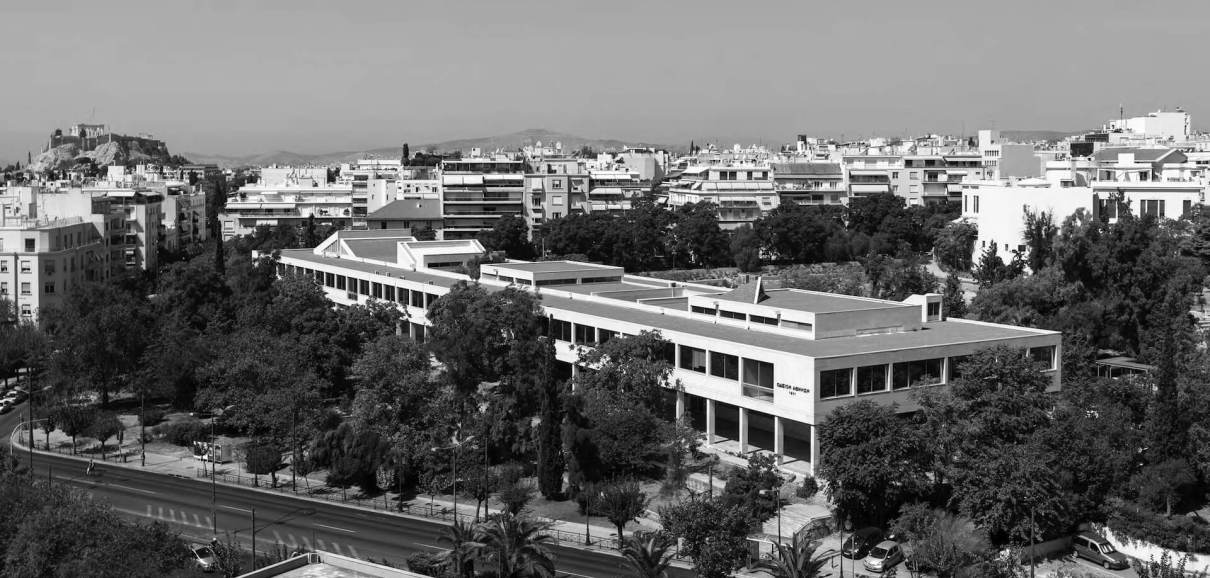
The Conservatoire is housed at an emblematic building, a prime example of the Bauhaus style designed in 1950 by the Greek architect Ioannis Despotopoulos. It was part of his big award-winning project for a “cultural agora”, that would bring together in one place an Opera house, a Portrait Gallery, a Conservatoire, research centers, an open-air theatre –and more- that was not completed. Could you tell us more about the building and Despotopoulos’ original vision?
As far as the architectural concept of the building, the responsibility to manage the work of such an imporotant architect as Despotopoulos is great. On the other hand, you cannot keep all the architectural and functional concepts of the 50s, since the building has now new uses and possibilities. There is a process of modernization and adaptation so that the building can function without compromising its basic architectural qualities; this is the balance we have tried to maintain. Right now we are hosting an exhibition, offered to us by the Goethe Institute and the Benaki Museum, which presents Despotopoulos and his relationship with the Bauhaus movement, as well as some plans of the building and the original concept of its integration in a wider cultural centre. Among the plans was building an Opera House at the triangle where avenues Vassilissis Sophia and Vasileos Konstantinou meet, with its entrance facing the Hilton hotel. An amusing detail is that Despotopoulos was somewhat bothered by the building of the Duchess of Placentia (now the Byzantine Museum) and in one of the versions, he had thought of moving it a little further. Be that as it may, in the end the only building of this whole project that was built is the Conservatoire.
This is roughly the architectural history of the building. I don’t know whether this building is properly classified as Bauhaus, there is a lot of debate about it among architectural historians. It definitely has many of the characteristics of the Bauhaus movement, such as the visibility of materials, the bricks and the cement, and also its philosophy, that function takes precedence over form. Decoration is present, but is very abstract: if you pay attention you will see everywhere a combination of shapes, an oblique line with a semicircle and a vertical line; it is a very distinctive signature of Despotopoulos. The building has many such surprises; it is very interesting and very original. It looks like the Bauhaus buildings you see in other countries, but at the same time it doesn’t look like them, because it is distinctly Mediterranean, there’s this feast of windows and openings. It is also quite “wasteful” in terms of space, the stairs and the waiting areas are endless.
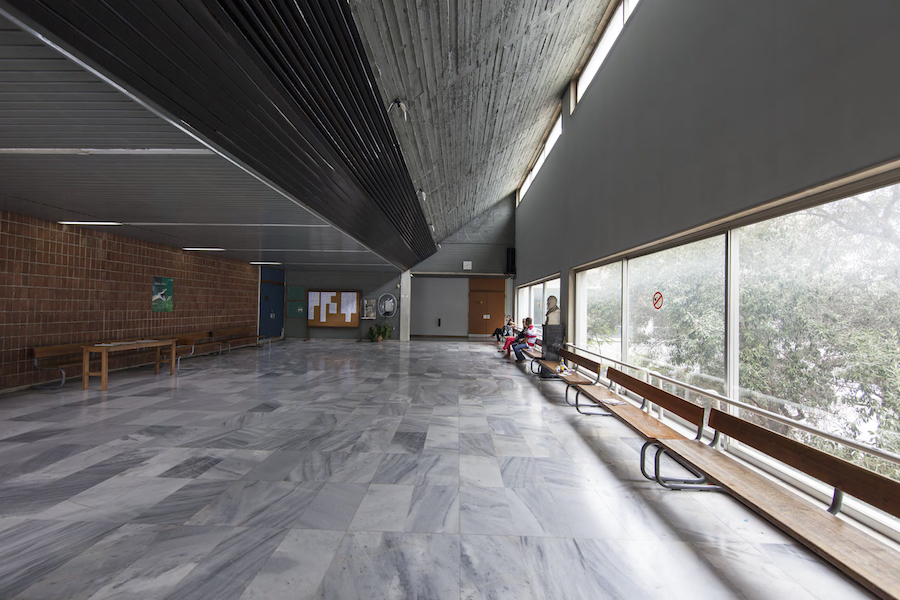
Since 2013, when you became president of the Conservatoire, the building entered a new chapter: several refurbishments started to take place, among them the revamped Aris Garoufalis hall and the new Ω2 multi-space. When will the renovation be complete and what can the public expect to see then?
The building has a long history. I can tell you that it is the great blessing and the great curse of the Conservatoire, in the sense that it remains unfinished and has suffered enormous damage in the four or five decades since the construction works stopped. The building is four stories in essence, of which only the ground floor and the first floor are visible, the rest is underground. Well, when we say that the building needs completion, we don’t mean the outside shell you see, but the basements and ground floors which were still being constructed when the works stopped. The year 2013 was very difficult for the Conservatoire; a lot of outstanding financial obligations, many debts and a building which was collapsing around us. It was a very difficult phase. After that, a change of course began, based on the logic that the only solution for the long-term sustainability of the Conservatoire was the utilization its greatest asset, this building.
Based on his logic and with the help of private donors we were able to fund a project for the completion and modernization of 1/3 of the remaining building. The project, taken on by the architectural firm Papagiannis and the architect Sidiropoulou focused on how the building can be completed, be functionable and at the same time be economically viable. The rational of their proposal was to add to the building parallel functions in line with our objectives, such as pedagogy, arts, and youth creativity. These functions mainly concern cultural infrastructures of the building that we can immediately put into use and get results. One of these infrastructures is the amphitheater of the Conservatoire that was left unfinished and had been locked since 1976. We are talking about a 600-seat amphitheater, in the center of Athens, right next to the Presidential Palace! It is an amphitheater designed as a venue for concerts as well as conferences, as it has been designed for a use that includes speech-giving. Hopefully it will be operational by September and it will host conferences, theater, dance and music. There will be a second, more experimental music venue, which we call the ‘new stage’, it has about 200 seats and will work as a sort of “black box”, a very flexible layout for more experimental stuff. Foyers for these two venues will also be constructed, including a large space that will be available for events.
A central entrance will be opened on Rigilis Street, giving a better perception of the building and making it more accessible and welcoming to the public. There, along with the entrance to the lower floors, a cafe-restaurant will also be housed. The project is complemented by a suite of technology studios, constructed on the other side of the building. So this is roughly the completion of what we call cultural infrastructures. There is still more to be done. The floor here that we’re on (ground floor) definitely needs an intervention; it’s probably the most energy-intensive building I know, with all these big windows that don’t have double glazing. Other areas, mainly teaching areas, also need renovation. There is also the Ω2 space, which has been cleaned and opened, and has been used for events; however it still needs a lot of work.
So by next season you we have the amphitheater and the New Stage, a very pleasant cafe-restaurant on Rigillis Street, and we will continue to try for the rest. There are many prospects. 2013 was a very dark year, it was the peak of the crisis in Greece and the death of Aris Garoufalis, a great personality and the president and director of the Conservatoire. We came very close to disaster. The first sign that the Conservatoire and the building was worth fighting for was the tremendous support from private funders, thanks to which we were able to pay for the architectural proposals and to have a project ripe for inclusion in EU funding. What we will try to do now is to combine the private but non-profit character of the association with a cooperation with the Ministry of Culture and the Ministry of Education.
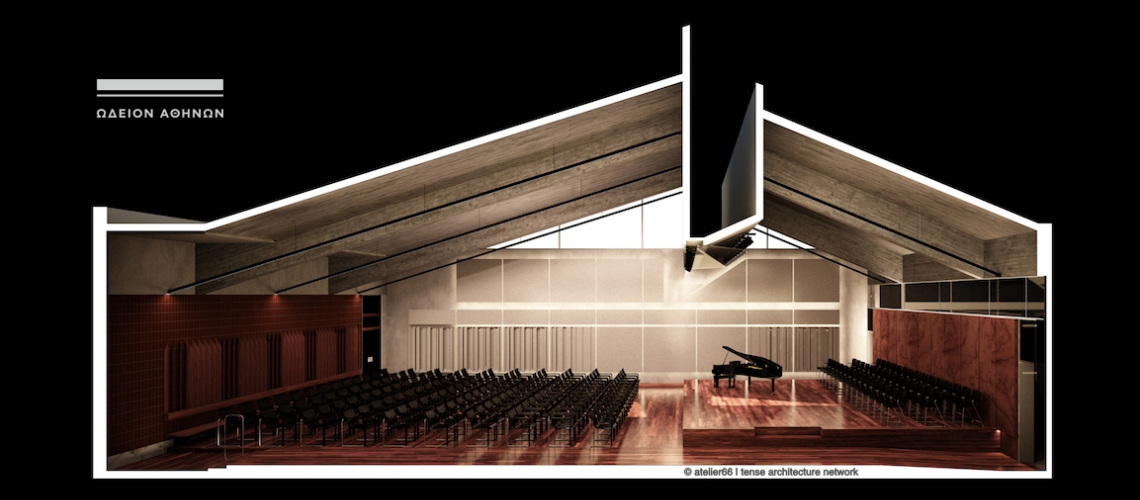
I understand that the Conservatoire is also home to an expansive archive available to researchers and students, thanks to which a lost opera was discovered.
The archive was created in 2014. We discovered in the basements of the Conservatoire stacks of papers and books and which were unsorted and in a poor condition, left there since the move from Piraeus Street in 1976. With the help of the Folk Music Laboratory of the Ionian University, and musicologists and librarians from there, we started to sort it out and discovered that is was of major historical significance. This archive is perhaps the most important archive in Greece regarding the performing arts, mainly music but not only. By studying the archive, one learns -and revises- a lot regarding the music history of Greece. The school records of the early 20th century, for example, are an x-ray of Greek society at that time. It is very interesting. In order to best utilize the archive, we established and internal department called the “Research and Documentation Center of the Athens Conservatoire” headed by Christos Afroudakis and Stella Kourbanas, as a curator of the archive. We have already made publications based on the work of this center: two books on historic issues, a quarterly magazine “Neos Musikos Helleninomnimon” on research issues, and under way is the publication of a three-volume work on “The history of music in modern Greece”, where the most recent research findings of the archive are chronicled. The first volume has already been published, and the entire project is being carried out thanks to a funding from KIKPE (Public Beneficial Foundation for Social and Cultural Project), within the National Bank’s initiative for the bicentennial 1821-2021.
In fact, as part of this initiative, a lost opera by a great Corfu composer, Alexander Grek, was discovered; the composer is not particularly well-known in Greece because he worked in Alexandria, which was known to be a multicultural city. This work was considered lost until it was found here and we presented it as an opera last January. This is all very interesting. The archive is a treasure, which is still being recorded and from which we are constantly learning. There is a EU funding program for the digitization of the archive, so that it becomes more widely accessible. But there are already scholars working inside and it is open to students.
The Athens Conservatoire offers studies in Music, Theatre and Dance, as well as a Bachelor in Music in collaboration with Goldsmiths College. Could you outline the Conservatoire’s educational goals and priorities?
In Greece, all conservatories have exactly the same status, the diplomas they provide are unclassified, that is, they are not recognized as tertiary education degrees. In other words, graduates of Greek conservatories are currently working as high school graduates. In the case of the Athens Conservatoire, we considered this scandalous because the Conservatoire has been a huge investment by the state as well as by all major private donors from the 19th century until today, it is a 14,000 square meter building in the center of Athens, with a very important architectural signature. It’s a shame that all this investment is not fully utilized because the diplomas we give are unclassified.
In 2013-14 we approached the School of Fine Arts of the University of Athens and the Ministry of Education and proposed to them that we create something that is missing in Athens, a top University Department in music performance, a music academy. Higher studies in music performance exist at the University of Macedonia in Thessaloniki and the Ionian University in Corfu, but they do not exist in Athens. There is of course the Department of Music Studies of the National and Kapodistrian University of Athens, but its degrees are in musicology, not music performance. Unfortunately, these efforts did not succeed, so we developed our own curriculum in collaboration with Goldsmiths College of the University of London. We offer a Bachelor of Music which allows our students, if they choose, to do their studies in Greece and get a degree from Goldsmiths College, which gives them professional rights in Greece and is academically recognized throughout the rest of the world. The programme begins this September, is a demanding four-year programme with tuition fees that are however relatively low.
In the meantime, we continue to operate as a Conservatoire and, in addition to the collaboration with Goldsmiths, we are developing the relationships of all our schools with the outside world. For example, until the Ukraine war, the drama school had a very beautiful collaboration with the Moscow Academy. This is now replaced by a collaboration with the Erasmus Academy in Berlin. At the same time, the School of Dance recently collaborated with the Israeli Embassy. Our Centre of Early Music offers new insights into historically informed performance to a growing number of students, in collaboration with international institutions such as the Haute École de Musique of Geneva and the Festival of Ambronay in France. We try to forester international dialogue and to be open to the outside world because we consider that being confined in one’s small surroundings is extremely harmful. Apart from these projects, we are making an effort – in very close cooperation with the State Conservatoire of Thessaloniki – to renew the curricula of Greek conservatories, which are outdated and in dire need of modernization. We believe it is our obligation as a non-profit organization that also enjoys some state support, to be part of an effort to bring these curricula up to date.
As you can see, the matter is quite complicated, since the Athens Conservatoire has the three schools (music, dance and drama), plus the college that will operate from September in collaboration with Goldsmiths, plus the Research and Documentation Center, so in total there are five different entities in the same organization. In addition, we have this building which begs to function as a cultural center. We are not naive to think that we could do what Megaron, Stegi or SNFCC does, but I think there is an angle that remains obscure and that I want us as a Conservatoire to explore: young artists at that time in their life after they have finished their studies but before they are established; it is a period of horrible suffering and loneliness, during which they make the worst and the best art they will ever make. And our goal, our philosophy if you will, is that all these cultural infrastructures I mentioned, beyond the economic sustainability they give to the Conservatoire, serve artists in this period of their lives. Everything else flows from that. The many schools we have, the initiatives, the extroversion and our international collaborations. The main goal of all this is to help young artists at the end of their studies, to give them a space where their works will be performed, where they can work and experiment.
